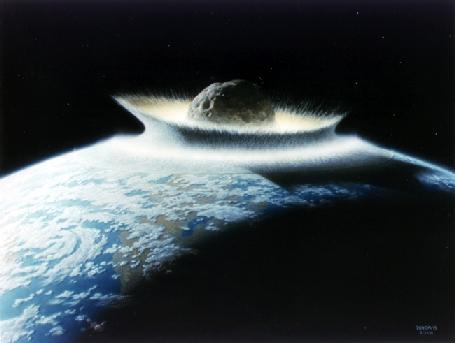Geology & Paleontology
Subtopics: Nemesis Comet Showers Impacts: History Asteroid Deflection
 |
An artist's impression of a giant impact of an asteroid hitting the Earth (NASA). |
Part of my research has involved collaborations with geologists and paleontologists. In 1984, I co-authored a paper in which we suggested that the Sun might have a companion star, tentatively called Nemesis, as the trigger that might have caused an apparent periodicity in the ages of craters and mass extinctions on Earth. Whether or not Nemesis exists is still an open question, but it should be settled before too long, when infrared all-sky surveys will either find Nemesis (or Kali, as I would prefer to call the star), or exclude its existence.
A few years later, around 1988, I focused on the punctuated character, rather than a possible periodicity, of both impacts and mass extinctions, by studying the phenomenon of comet showers, that could be triggered by any type of perturbance from outside the solar system. It is quite likely that the rate at which comets enter the planetary system from the Oort cloud is highly variable over time scales of millions of years and longer, and a close passage of any type of star, bound or unbound to the sun, will enhance the probability of impacts on Earth.
In 1991, I was one of a few astronomers who almost discovered the first Kuiper Belt objects, cometary bodies at the edge of our planetary system.
Recently, improvements in technology have given us new ways to protect the Earth from the danger of large impacts. It may soon be possible to deflect asteroids that are on a collision course with the Earth. For example, we could launch a plasma engine and use that to gentle change the orbit of a dangerous asteroid, over a period of a year or longer, as long as we have sufficiently early warning.